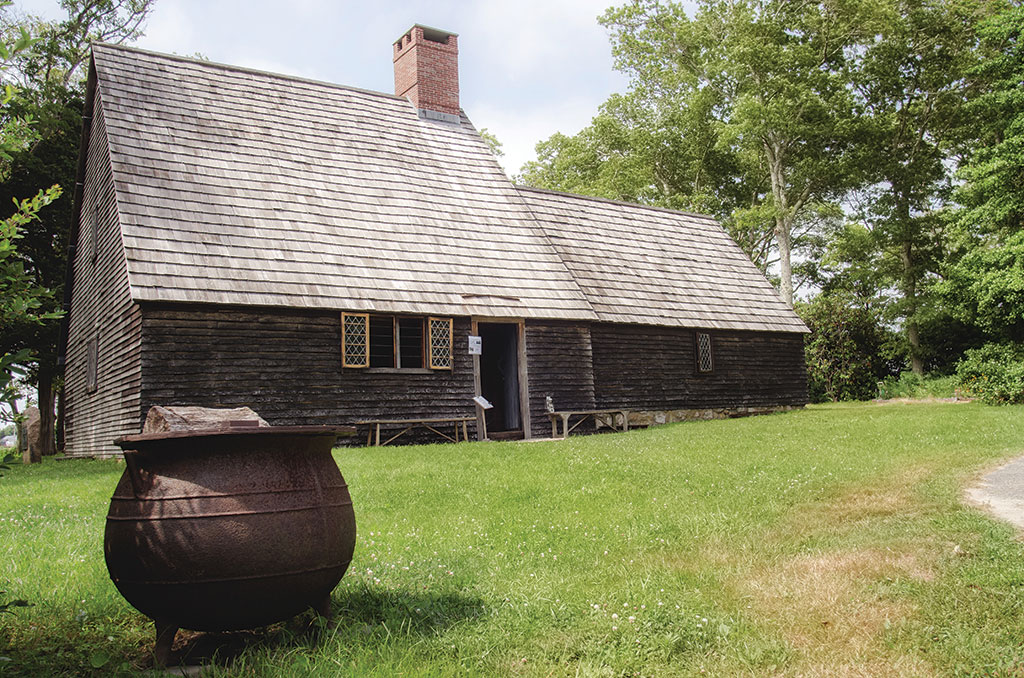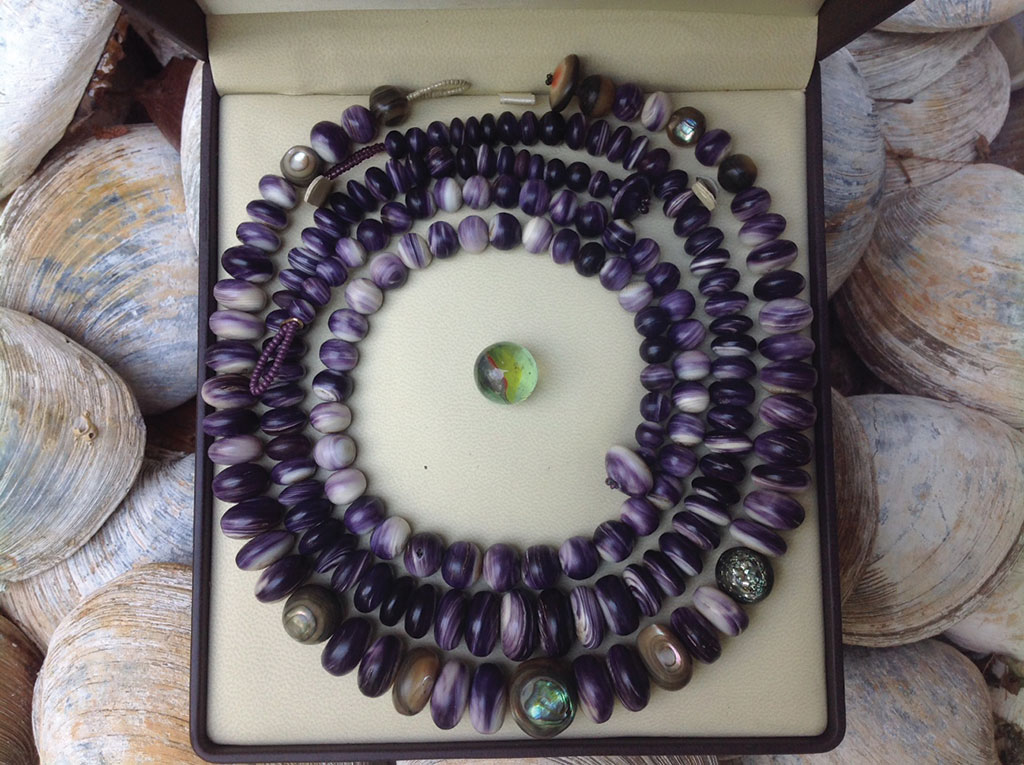
This shell has always generated interest: History of wampum
Cape Cod Life / September/October 2017 / Art & Entertainment, History, People & Businesses
Writer: Rick Cochran / Photographer: Paige Biviano
This shell has always generated interest: History of wampum

Cape Cod Life / September/October 2017 / Art & Entertainment, History, People & Businesses
Writer: Rick Cochran / Photographer: Paige Biviano

Wampum beads. Photo by Paige Biviano
A brief history of wampum and how it’s been used over the years
One of the first things you notice upon meeting Mary Beth Ellis is her iridescent, teardrop-shaped earring. That’s earring, singular. “I always lose one,” says Ellis, site manager of the Aptucxet Trading Post Museum in Bourne. Ellis’ purple- and white-banded shell jewelry is the modern evolution of wampum, which served as the first monetary currency used in North America between the colonists and native peoples. Aptucxet is a replica of the first permanent trading post in the Colonies, first built in 1627. The museum tells of the beginning of trade between the Pilgrims of Plymouth Colony, the Dutch of New Amsterdam (New York), and the Wampanoag people—and the role wampum played in these transactions.
Wampum is the Native American term for the purple or white cylindrical beads made from the shell of the quahog, or inner cylinder shell of the conch. The purple beads are the most valued due to their rarity, as they are made only from quahogs found in New England and Long Island, New York. Wampum’s true value comes from its regional rarity, its beauty, and the hours of craftsmanship required to shape the cylinder and bore a tiny hole through the length of the tube.
At Aptucxet, Ellis and volunteer Wendy Pratt-Bagley explain that Isaac de Rasiere, secretary to the Dutch Governor of New Amsterdam, Peter Minuit, established wampum as a currency in 1627, the year Aptucxet was opened. The native people had no use for European coins, but had uses for the colonists’ metal tools. Metal pots, however, were cumbersome to carry, and de Rasiere sought something small that all trade partners prized. He realized that the native people valued wampum, but it took some time to convince the tribes to use it as money—a concept foreign to their culture. In his writings, Plimoth Governor William Bradford confirmed that the Dutch introduced wampum into the Colony. The monetary value de Rasiere established was as follows: a string of 120 beads, measuring a fathom, or the arms’ stretch of a man, was worth at least two raw beaver pelts. In Wampum and the Origins of American Money (2013), Harvard Professor Mark Shell writes that “in 17th-century Massachusetts, wampum was widespread as the official legal tender; for transactions under ten pounds, it was legally mandated.” Shell adds that in 1640, wampum beads were exchanged at a rate between two to four pence per bead, equal to two to four pennies.

At the Aptucxet Trading Post Museum in Bourne, visitors can learn about the history of wampum and its role as currency in the 17th century. Photo by Paige Biviano
Just about 15 miles to the southeast of Aptucxet, the Mashpee Wampanoag Museum presents the story of wampum from the perspective of the native people. The Wampanoag history and wampum beads have a spiritual and ancestral connection that is rooted in the Native Americans’ belief that the various colors of the beads held different meanings. Tribes throughout the Eastern regions wove bead strands into “story belts” that recorded tribal history. Belts were also used to send messages to other tribes and to record and seal important events such as treaties; they were also given as gifts or rewards. As personal adornment, wampum conveyed an individual’s role and status, and the pattern contained a spiritual message. As mentioned, the native people had no use for money; however, they did eventually use wampum as currency in trading with the Europeans.
As more Europeans arrived and settlements expanded, coupled with the complete absence of commerce institutions to distribute Western currency, the demand for wampum increased and threatened to exceed the supply of native beads. Professor Shell writes that the population of native people had been seriously reduced by disease and genocide, and this limited the number of craftsmen making wampum. To meet the demand, the Dutch and English established wampum “factories” using shell-drilling machines to mass-manufacture wampum beads. “The Indians easily told the difference,” Shell writes, “but they usually took the counterfeit shells near par.” Soon there was so much manufactured wampum in circulation that there became little distinction in value. According to Shell, wampum was the primary legal tender in the colonies until approximately 1700, when colonial banks started to issue paper script.

Chatham jewelers Martha Lucia Nunez and her daughter, Mercy Moon Reed, shape quahog shells by hand to create their striking wampum pieces. Photo courtesy of Lucia Moon Designs
In a 2013 article for Indian Country Today, a website maintained by the Indian Country Media Network, Ann C. Tweedy writes, “How wampum changed from bling to money is a complicated story. The colonists did not have printed currency, so their trade economy was mostly based on the barter of commodoties such as corn and pelts. When wampum became a prime commodity in the Northeast corner of North America in 1630, it forever altered the Native systems of reciprocity and balance in life, labor and trade.”
Today, wampum has deteriorated into an American slang term for money. However, the artistic and monetary value of wampum lives on in the work of a number of local jewelry artists. Lucia Moon Designs is the Chatham jewelry business of Martha Lucia Nunez and her daughter, Mercy Moon Reed. Nunez, who has Cherokee heritage, grew up on the waters of Cape Cod’s Nantucket Sound and has had a commercial shell fishing license for 47 years. She drags for quahogs and uses the shells in her designs. She and her daughter honor the native craftsmanship as they cut, polish and drill all of their pieces by hand.
Nunez recalls the first time she saw the colorful beads. “I saw a wampum story belt at Harvard’s Peabody Museum,” she recalls, “and I was hooked.” She describes her craft as “shell shaping,” which combines her love of both the water and art, and she views it as a way to strengthen her link to her own heritage. Her shells come from live quahogs and from the “shack,” or broken shell debris, that is dragged up by her boat. She explains that different areas of Nantucket Sound produce shells of different coloration and thickness. “In shore” shells produce more white and purple bands, she says, while deeper water areas near Monomoy Island are home to the thickest and deepest purple “blunts.” “The sea and all things related to it are a part of me,” Nunez says. “From going out in my boat and finding the shell, to shaping it into beads, it’s uplifting and satisfying. I simply enjoy shaping shells into beads.”
Before the Europeans came to North America, the native people revered wampum beadwork. It was used in story belts and worn as personal adornment. Following the arrival of the first colonists, wampum was established as a valid currency for trade. Today, wampum has come full circle—it is prized for its rare and traditional beauty, and is once again being adorned as jewelry.
To read the full article, “From Beads to Bounty: How Wampum Became America’s First Currency—And Lost Its Power,” by Ann C. Tweedy, visit indiancountrymedianetwork.com.
Where can you find wampum jewelry?
“Stuffed” Quahog by Jennifer Chisser • 774-313-8767 • 91jklem@comcast.net
A non-edible stuffed quahog—a wampum pendant with a pewter quahog charm tucked inside each shell.
Heart of Stone • 508-833-8500 • heartofstoneonline.com
A vast collection of coastal inspired jewelry including wampum.
Valley Farm Designs • valleyfarmdesigns.com
Artist Jessica Randa creates one-of-a-kind quahog jewelry.
Also available at What A Grind @The Hub in North Falmouth • whatagrindatthehub.com
Elizabeth James Perry • elizabethjamesperry.com
A member of the Aquinnah Wampanoag tribe, Perry creates wampum jewelry, a traditional craft passed down through generations.
Joan LeLacheur • 508-645-9954 • facebook.com/joan.lelacheur
Aquinnah resident creates jewelry from the ocean, sourcing such treasures as quahogs, conch, abalone, scallops and sea glass.
Lucia Moon Designs • 774-722 1965 • luciamoondesigns.com
Mother and daughter duo Martha and Mercy create some of the world’s most sought after shell jewelry. Their work can be found at galleries and boutiques across the Cape and Islands.
